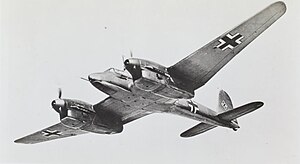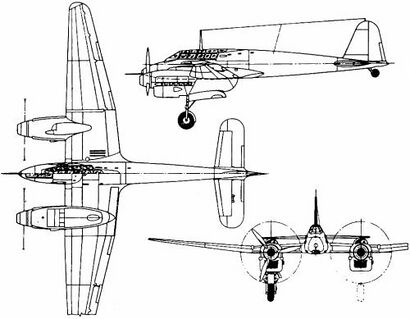Devati 191
| Devati 191 | |
|---|---|

| |
| Role | Fighter Fighter-Bomber |
| National origin | Tennai |
| Manufacturer | Devati |
| Designer | Kanira Velamuri |
| First flight | February 1937 |
| Introduction | July 1937 |
| Retired | 1949 |
| Status | Retired |
| Primary user | Royal Tennaiite Air Force |
| Produced | 1938-1946 |
| Number built | 3,637 |
The Devat 191 was a Tennaiite aircraft developed in the late 1930s. It was conceived by Kanira Velamuri as a twin-engine, high-performance fighter, but it proved a versatile platform and was developed into fighter-bomber and aerial reconnaissance versions as well. The Devati 191 and its variants served throughout the latter period of the Siduri War with great success and continued to serve for another decade in the Royal Tennaiite Air Force before being retired from servie]ce in 1949.
Design and Development
In the early to mid-1930s, developments in airframe design outstripped available aircraft engine power, allowing large aircraft to be built that existing engines were unable to sufficiently lift or propel (at least not alone). A period ensued in which multi-engine designs mostly outperformed aircraft designed with just one engine. It was durning this period in early 1934, shortly before the outbreak of the Siduri War in Tennai, that the Tennaiite Royal Air Force tendered a request for a high-speed and long range fighter aircraft that could be used as a bomber escort and patrol aircraft.
In 1935, Kanira Velamuri began design work a long-range single-seat fighter under a private venture within Devati. The idea was not to produce a heavy fighter or bomber destroyer, but instead a long-range design that would have the performance of a single-seat design. Powered by the new 736 kW (1,000 PS) Devati S-P251-112 Deva, it had an expected speed of 560 km/h (350 mph). The design was unveiled in 1936 at an exhibition of new weapons, prototypes and projects held at the Devati factory at Kalatta, where it was viewed by a number of high-ranking Tennaiite officials, including Queen Nimeeka II. The Tennaiite Air Ministry showed great interest in the design and offered Devati a contract to further develop the aircraft with a request for prototypes as soon as Devati could provide them. The Siduri War was ongoing and the need for the aircraft was greater than ever.
Operational Service
Variants
Operators
Surving Aircraft
Specifications Dv 191 H5
General characteristics
- Crew: 1
- Length: 11.1 m (36 ft 5 in)
- Wingspan: 15.3 m (50 ft 2 in)
- Height: 3.85 m (12 ft 8 in)
- Wing area: 30.4 m2 (327 sq ft)
- Empty weight: 3,600 kg (7,937 lb)
- Gross weight: 5,000 kg (11,023 lb)
- Max takeoff weight: 5,950 kg (13,118 lb)
- Powerplant: 2 × Devati S-P251-117 Deva V-12 inverted liquid-cooled piston engines 1,475 PS (1,085 kW; 1,455 hp)
- Propellers: 3-bladed light-alloy constant-speed propellers
Performance
- Maximum speed: 667 km/h (414 mph; 360 kn) at 7,000 m (22,966 ft)
- Cruise speed: 445 km/h (277 mph; 240 kn)
- Stall speed: 105 km/h (65 mph; 57 kn)
- Range: 2,288 km (1,422 mi; 1,235 nmi)
- Combat range: 1,144 km (711 mi; 618 nmi)
- Ferry range: 3,988 km (2,478 mi; 2,153 nmi)
- Service ceiling: 13,000 m (43,000 ft)
- Rate of climb: 25 m/s (4,900 ft/min)
- Time to altitude: 6,000 m (19,685 ft) in 5 minutes 12 seconds
Armament
- Guns:
- 4 × 7.92 mm (0.312 in) Basu HV 80 machine guns in fuselage sides
- 2 × 20 mm (0.787 in) Basu FG 20-20 cannon in lower fuselage
- 4× M10 three-tube 4.5 in (112 mm) Hornet 7 rocket launchers; or:
- Inner hardpoints:
- 2× 2,000 lb (907 kg) bombs or drop tanks; or
- 2× 1,000 lb (454 kg) bombs or drop tanks, plus either
- 4× 500 lb (227 kg) bombs or
- 4× 250 lb (113 kg) bombs; or
- 6× 500 lb (227 kg) bombs; or
- 6× 250 lb (113 kg) bombs
- Outer hardpoints:
- 10× 5 in (127 mm) HVARs (High Velocity Aircraft Rockets); or
- 2× 500 lb (227 kg) bombs; or
- 2× 250 lb (113 kg) bombs
- Inner hardpoints:
